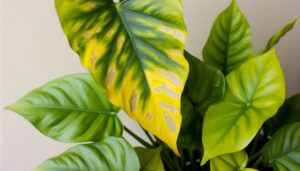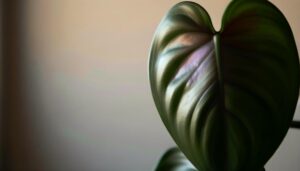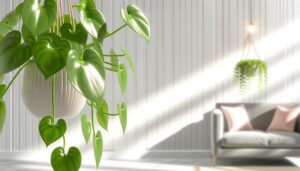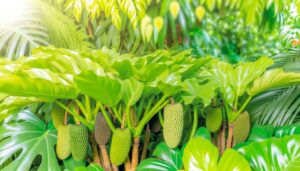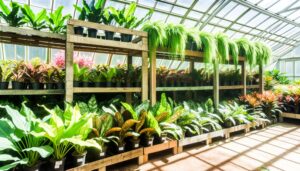What Are the Characteristics of Philodendron Plowmanii 'Dark Form'?
Philodendron Plowmanii 'Dark Form' displays deeply corrugated, heart-shaped leaves characterized by a strong venation pattern and pronounced, ridged surfaces. The leaves exhibit a deep green hue with noticeable shininess and smooth, undulating margins.
Its coloration remains consistently uniform, indicative of high chlorophyll concentrations. This variety follows a sequential leaf development pattern and employs aerial roots and tendrils for climbing.
Best growth occurs in indirect light, within a temperature range of 65°F to 80°F, and high humidity levels. For enthusiasts seeking detailed information, the intricacies of its care and propagation techniques await further exploration.
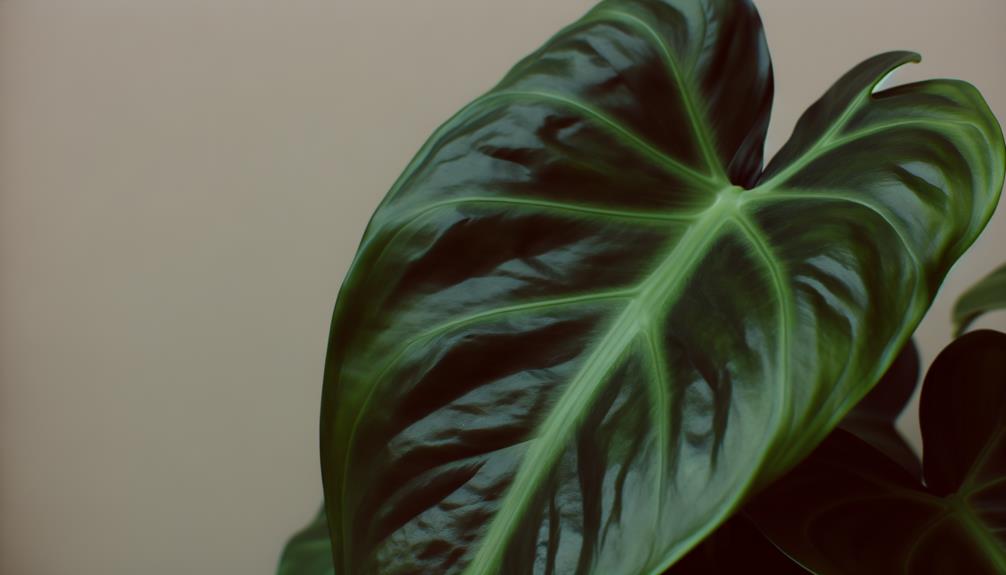
Key Takeaways
- Deeply corrugated, heart-shaped leaves with pronounced ridged surfaces.
- Robust venation pattern and smooth, undulating leaf margins.
- Deep green hue with notable shininess and distinct color variation patterns.
- High concentrations of chlorophyll result in uniformly consistent coloration.
- Climbing and spreading behavior with sequential leaf development stages and utilization of aerial roots.
Leaf Structure
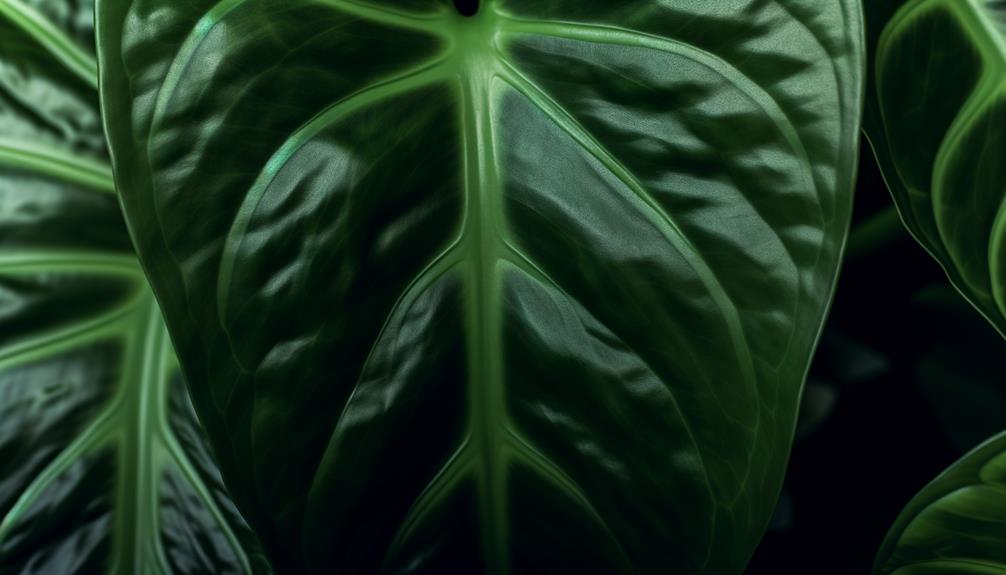
Characterized by its deeply corrugated texture, the leaf structure of Philodendron Plowmanii 'Dark Form' exhibits a robust and intricate venation pattern that enhances its aesthetic appeal.
The leaves are heart-shaped, with pronounced, ridged surfaces that create a tactile experience reminiscent of a finely grooved sculpture. Each leaf's primary vein is prominently displayed, extending from the petiole and giving rise to secondary and tertiary veins that form a network of interconnecting lines.
This venation not only contributes to structural integrity but also facilitates optimal nutrient and water distribution. The leaf margins are smooth and undulating, adding to the overall visual complexity.
Such structural features are indicative of the species' adaptation to its native tropical environment, promoting both durability and efficiency in physiological processes.
Foliage Color
The Philodendron Plowmanii 'Dark Form' is characterized by its deep green hue, which provides a rich and vibrant aesthetic.
The leaf surface exhibits a notable shininess, enhancing its visual appeal and indicating a healthy, well-hydrated plant.
Additionally, this species displays distinct color variation patterns, often featuring subtle gradations and veining that contribute to its complex and dynamic appearance.
Deep Green Hue
Exhibiting a deep green hue, the foliage of Philodendron Plowmanii 'Dark Form' displays a rich and vibrant coloration that distinguishes it from other varieties. This intense green pigmentation results from high concentrations of chlorophyll, enhancing the plant's photosynthetic efficiency.
The leaves' coloration is uniformly consistent, with minimal variegation, ensuring a visually cohesive appearance. Detailed observation reveals that the deep green hue extends from the central vein to the leaf margins, providing a striking contrast against the more subdued tones of the plant's stem.
This verdant shade is maintained throughout various growth stages, indicating stability in the plant's genetic expression. The deep green hue not only contributes to the plant's aesthetic appeal but also signifies its robust health and vigor.
Shiny Leaf Surface
With a glossy texture, the leaf surface of Philodendron Plowmanii 'Dark Form' reflects light, creating a striking visual effect that enhances its deep green hue. This lustrous sheen is a result of the leaf's unique epidermal cell structure, which optimizes light reflection. The reflective surface not only contributes to the plant's aesthetic appeal but also serves a functional role in maximizing photosynthesis efficiency by reducing light absorption.
| Feature | Observation | Significance |
|---|---|---|
| Glossy Texture | Reflects light effectively | Enhances visual appeal and photosynthesis |
| Epidermal Structure | Unique cell arrangement | Optimizes light reflection |
| Light Reflection | High reflectivity | Reduces light absorption |
| Aesthetic Impact | Striking visual effect | Amplifies deep green hue |
This combination of reflective properties and structural composition makes the Philodendron Plowmanii 'Dark Form' an enchanting specimen in any botanical collection.
Color Variation Patterns
Among the most distinctive features of Philodendron Plowmanii 'Dark Form' are the intricate color variation patterns observed in its foliage.
The leaves exhibit a remarkable gradient ranging from deep, velvety green to dark, almost black hues. This chromatic diversity is accentuated by subtle, silvery veining that traverses the leaf surface, creating a striking contrast.
The central vein often appears more pronounced, enhancing the visual complexity. Additionally, immature leaves tend to display lighter shades, which gradually darken as they mature, reflecting a dynamic developmental process.
This phenotypic plasticity not only contributes to the plant's aesthetic appeal but also serves as an adaptive mechanism in varying light conditions. Such patterns make the Philodendron Plowmanii 'Dark Form' a coveted specimen among botanists and horticultural enthusiasts.
Growth Patterns
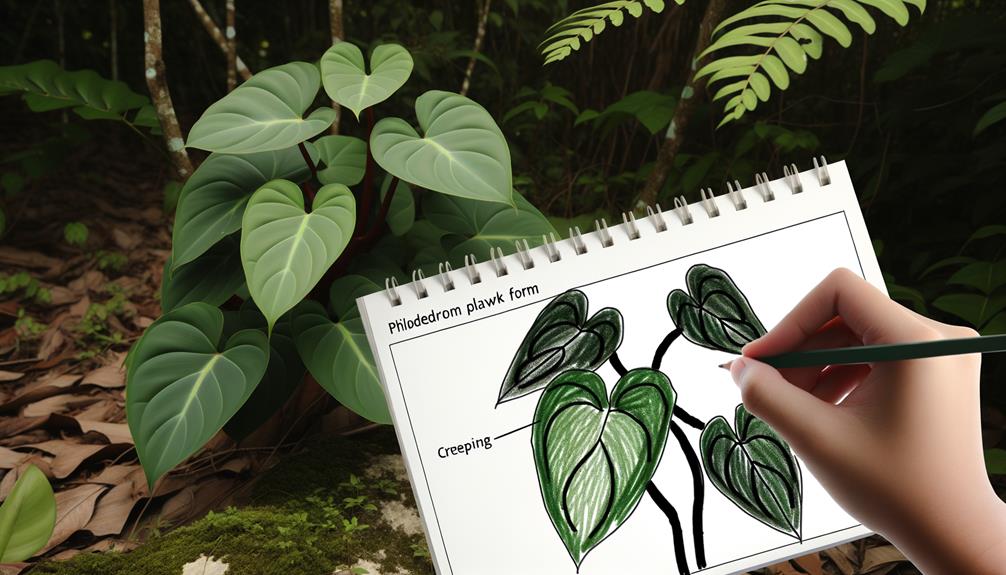
Philodendron Plowmanii 'Dark Form' exhibits distinct growth patterns characterized by sequential leaf development stages, evolving from juvenile to mature forms.
The species demonstrates both climbing and spreading behavior facilitated by its adventitious roots and elongating petioles, which enable attachment and horizontal expansion.
Understanding these growth dynamics is essential for optimizing cultivation and propagation practices.
Leaf Development Stages
The leaf development stages of Philodendron Plowmanii 'Dark Form' exhibit distinct growth patterns characterized by initial emergence as tightly coiled structures that gradually unfurl and expand.
Initially, the nascent leaves appear as compact, spiral forms enveloped by a protective sheath. As growth progresses, these leaves undergo a careful process of uncoiling, revealing a delicate, elongated lamina that continues to develop in size and texture.
The leaves mature into broad, heart-shaped configurations, showcasing a lustrous, dark green hue. Each stage of development is marked by a transformation in chlorophyll concentration and venation clarity, contributing to the plant's overall vibrant appearance.
This sequential unfurling is crucial for best photosynthesis and plant health, reflecting the plant's adaptive mechanisms to its environment.
Climbing and Spreading Behavior
Often displaying vigorous climbing and spreading behavior, Philodendron Plowmanii 'Dark Form' shows a tendency to extend its growth through both vertical and horizontal axes, using aerial roots and tendrils to anchor itself to surrounding structures.
This species utilizes a complex interplay of adventitious roots and flexible stems to achieve stability and ideal light exposure. Aerial roots, emerging from nodes along the stem, effectively adhere to surfaces such as tree trunks or moss poles, facilitating vertical ascension.
At the same time, its horizontal growth is characterized by lateral stem elongation, allowing the plant to spread into neighboring areas. This dual growth strategy not only maximizes spatial occupation but also enhances nutrient acquisition, thereby contributing to its strong and adaptable growth profile.
Light Requirements
Ensuring best light conditions is crucial for the healthy growth and vibrant foliage of Philodendron Plowmanii 'Dark Form.' This species thrives in environments with indirect, filtered light, mimicking its native understory habitat. Exposure to direct sunlight can cause leaf burn, leading to discoloration and damage. Conversely, insufficient light results in leggy growth and diminished leaf coloration.
| Light Intensity | Duration | Observations |
|---|---|---|
| Low | <4 hours | Stunted growth, pale leaves |
| Medium | 4-6 hours | Optimal growth, vivid leaf color |
| High | >6 hours | Risk of leaf burn |
| Direct Sunlight | Any time | Leaf scorch, wilting |
| Filtered Light | 6-8 hours | Best foliage health, lush growth |
Consistent medium to bright, indirect light is recommended to maintain its striking dark leaves.
Watering Needs
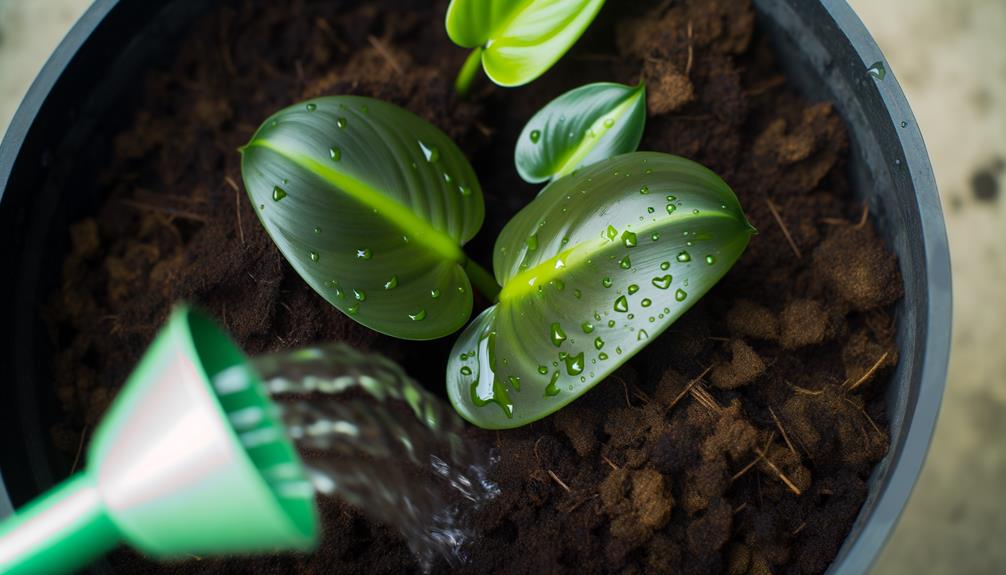
Philodendron Plowmanii 'Dark Form' requires consistently moist soil, yet it is essential to avoid waterlogged conditions to prevent root rot.
Best watering frequency should be determined by evaluating the top inch of soil; it should be allowed to dry before subsequent irrigation.
Noticing yellowing leaves and a mushy stem serves as signs of overwatering, requiring immediate corrective actions.
Ideal Moisture Levels
Maintaining ideal moisture levels is crucial for the healthy growth of Philodendron Plowmanii 'Dark Form', which thrives in consistently moist but well-draining soil. This species necessitates a delicate balance; the substrate should retain sufficient moisture without becoming waterlogged, which could lead to root rot.
Best soil conditions include a rich, organic mix that promotes aeration and drainage, such as a blend of peat, perlite, and pine bark. Regular monitoring of soil moisture is essential; using a moisture meter can aid in precise assessment.
In addition, ambient humidity levels should be kept between 60-80%, mirroring the plant's native tropical habitat. Ensuring these conditions will support robust foliage and overall plant importance, preventing stress-related issues common in suboptimal environments.
Frequency of Watering
Determining the most suitable watering frequency for Philodendron Plowmanii 'Dark Form' involves evaluating the plant's specific environmental conditions and substrate moisture retention capabilities. Ideal irrigation requires maintaining consistent soil moisture without waterlogging.
Typically, this Philodendron species thrives when the top 2-3 inches of the growing medium are allowed to dry out between waterings. Seasonal variations necessitate adjustments; during active growth phases, typically spring and summer, more frequent watering is needed, tapering off in autumn and winter.
High humidity environments reduce the frequency, whereas drier conditions may necessitate increased watering. Employing a well-draining soil mix, such as one incorporating perlite or orchid bark, further aids in maintaining an ideal hydration balance, ensuring root health and promoting robust growth.
Signs of Overwatering
Indications of overwatering in Philodendron Plowmanii 'Dark Form' often manifest as yellowing leaves, root rot, and a general decline in plant vigor due to anaerobic soil conditions. Excessive moisture disrupts the oxygen balance in the soil, leading to the deterioration of root health. This condition fosters pathogenic fungi proliferation, further exacerbating root decay.
| Symptom | Description | Consequence |
|---|---|---|
| Yellowing Leaves | Leaves lose vibrant green hue | Nutrient deficiency |
| Root Rot | Roots become black, mushy | Impaired nutrient uptake |
| Leaf Drop | Leaves fall prematurely | Reduced photosynthesis |
| Foul Odor | Soil emits unpleasant smell | Pathogen presence |
| Wilting | Plant appears limp despite watering | Root system failure |
Attention to proper watering practices is imperative for maintaining the health of Philodendron Plowmanii 'Dark Form'.
Soil Preferences
Peak growth of Philodendron Plowmanii 'Dark Form' requires a well-draining, nutrient-rich soil medium that retains moisture without becoming waterlogged. Ideal soil composition supports root aeration while preventing root rot, a common affliction in overly saturated soils. The perfect substrate should balance organic and inorganic components, providing essential nutrients and structural integrity.
To achieve this, consider the following soil mixture components:
- Orchid bark: Enhances drainage and aeration.
- Perlite: Improves soil structure, preventing compaction.
- Coconut coir: Retains moisture while maintaining good drainage.
- Compost: Supplies essential nutrients for robust growth.
- Activated charcoal: Mitigates odors and maintains soil freshness.
Humidity Levels
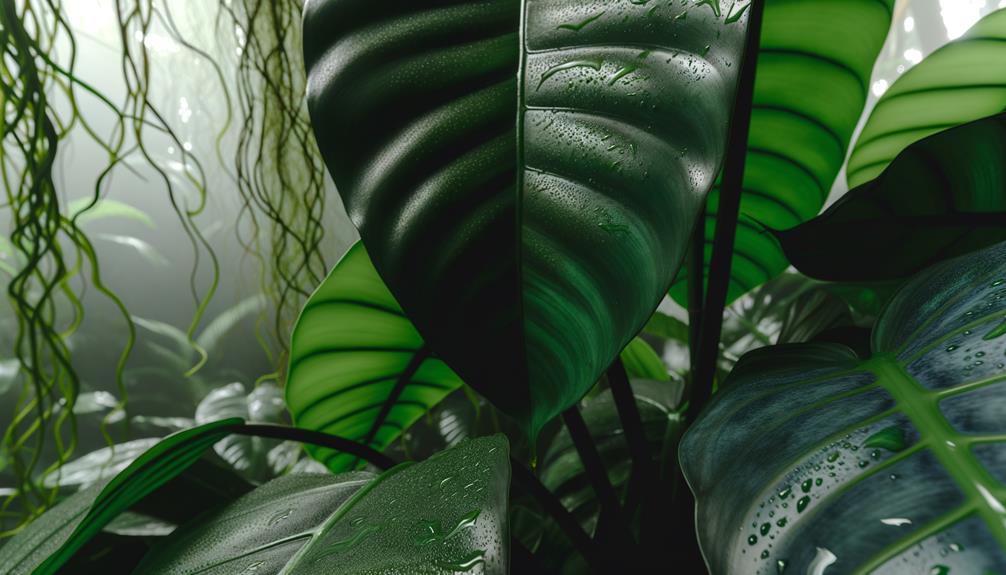
Ideal moisture levels are equally important for the thriving of Philodendron Plowmanii 'Dark Form', requiring an environment with relative humidity consistently maintained between 60% and 80%. Elevated humidity contributes to peak physiological processes, enhancing transpiration and nutrient uptake.
This tropical species, native to humid rainforest climates, exhibits diminished growth and potential foliar desiccation when subjected to suboptimal humidity. To maintain appropriate moisture levels, consider utilizing humidifiers, humidity trays, or strategic placement in naturally humid areas such as bathrooms or kitchens.
Regular misting can also enhance ambient moisture, although it should be used cautiously to prevent fungal infections. Continuous monitoring with a hygrometer ensures accurate regulation, fostering robust and lush foliage characteristic of the Philodendron Plowmanii 'Dark Form'.
Temperature Range
Philodendron Plowmanii 'Dark Form' thrives in temperatures consistently maintained between 65°F and 80°F, reflecting its native tropical habitat. Maintaining this temperature range is essential for optimal growth and health. Outside these parameters, the plant may exhibit signs of stress, such as slowed growth or leaf discoloration.
Key considerations for maintaining the best temperature:
- Temperature Consistency: Fluctuations should be minimized to avoid plant stress.
- Day and Night Variance: Mild variation between day and night temperatures is acceptable.
- Cold Sensitivity: Avoid exposure to temperatures below 55°F to prevent damage.
- Heat Tolerance: While tolerant of brief periods above 80°F, prolonged exposure can be harmful.
- Indoor Positioning: Place away from drafts, heating vents, and cooling systems to maintain stable conditions.
Understanding these temperature requirements will help the Philodendron Plowmanii 'Dark Form' thrive.
Fertilization Tips
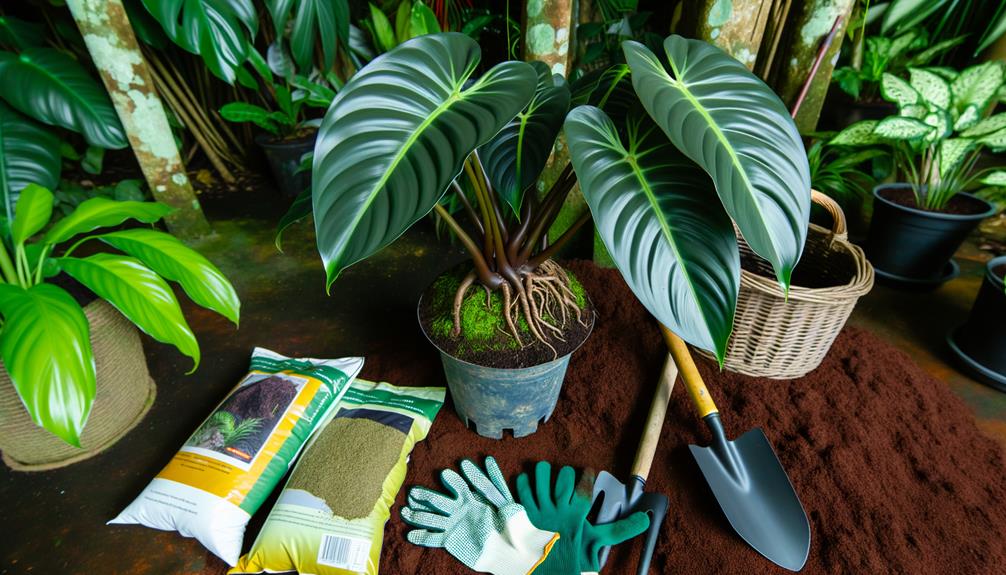
Proper fertilization is vital for ensuring the robust growth and vibrant foliage of Philodendron Plowmanii 'Dark Form.' Employ a balanced, water-soluble fertilizer with an N-P-K ratio of 20-20-20. Administer this fertilizer bi-weekly during the active growing season, typically spring through early autumn. Reduce the frequency to monthly during the plant's dormant period in winter. It is essential to dilute the fertilizer to half the recommended strength to prevent nutrient burn, which can damage the roots and foliage.
| Fertilization Aspect | Recommended Practice |
|---|---|
| Type of Fertilizer | Balanced, water-soluble (20-20-20) |
| Frequency (Growing Season) | Bi-weekly |
| Frequency (Dormant Season) | Monthly |
| Dilution Ratio | Half the recommended strength |
Adhering to these guidelines will support the plant's health and enhance its aesthetic appeal.
Pruning and Maintenance
Regular pruning and maintenance are essential for managing the growth and ensuring the overall health of Philodendron Plowmanii 'Dark Form.' Pruning not only shapes the plant but also removes diseased or damaged foliage, promoting vigor.
Maintenance tasks should be performed with sterilized tools to prevent infections. Key activities include:
- Leaf Trimming: Remove yellowing or dead leaves to enhance plant aesthetics.
- Stem Pruning: Cut back leggy growth to encourage a bushier appearance.
- Pest Inspection: Regularly check and clean leaves to mitigate pest infestations.
- Soil Aeration: Loosen soil periodically to improve root oxygenation.
- Water Management: Adjust watering schedules based on seasonal variations and plant requirements.
These practices contribute to the sustainable growth and resilience of the Philodendron Plowmanii 'Dark Form.'
Common Pests and Diseases
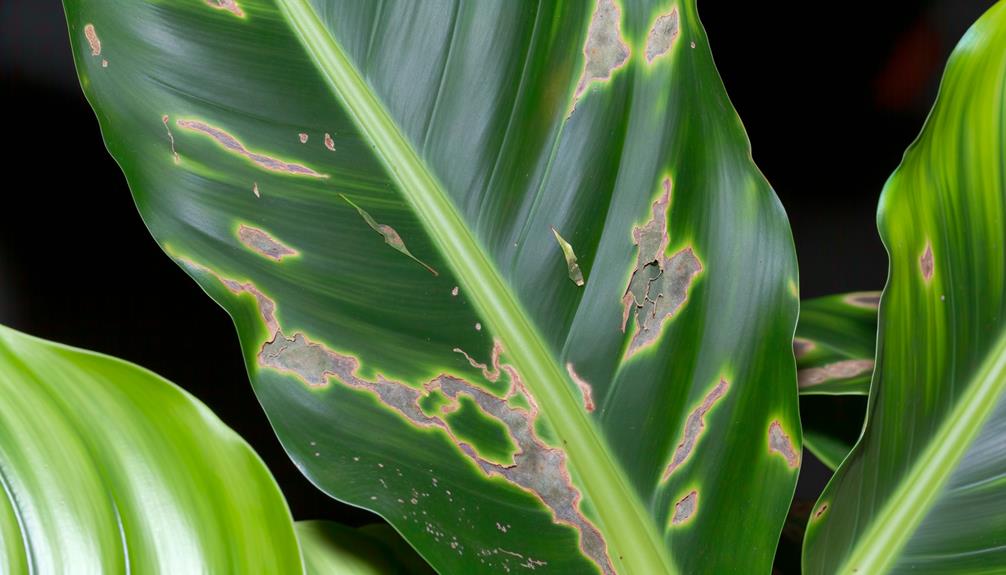
Susceptible to various afflictions, Philodendron Plowmanii 'Dark Form' often encounters common pests like spider mites, aphids, and scale insects, which can cause significant damage if not promptly addressed.
Spider mites thrive in dry conditions, creating webbing and stippling on leaves. Aphids, small sap-sucking insects, can cause curling and yellowing of foliage, leading to stunted growth. Scale insects, covered in protective coatings, latch onto stems and leaves, excreting honeydew that fosters sooty mold.
Additionally, the plant is prone to fungal infections such as root rot, often resulting from overwatering or poor soil drainage. It is crucial to regularly inspect and treat these issues with appropriate insecticidal soaps or fungicides to ensure the plant's health and essentiality.
Conclusion
Philodendron plowmanii 'dark form' displays a botanical symphony of detailed leaf structures, vivid foliage colors, and unique growth patterns.
Its requirements for light, water, and temperature establish a delicate balance similar to a finely tuned instrument.
Correct fertilization, careful pruning, and vigilance against pests and diseases support its peak health.
This plant's care is a choreography of scientific precision and natural beauty, demanding attentive observation and expertise to nurture its exceptional traits to their maximum capacity.

